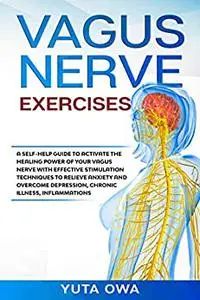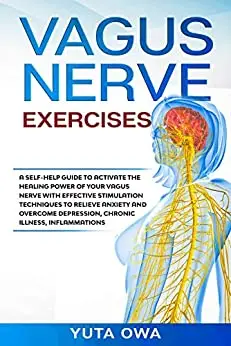VAGUS NERVE EXERCISES: A self-help guide to activate the healing power of Vagus Nerve with effective stimulation techniques to relieve anxiety and overcome depression, chronic illness, inflammations by Yuta Owa
English | 2020 | ISBN: N/A | ASIN: B08635725K | 158 pages | EPUB | 0.28 Mb
English | 2020 | ISBN: N/A | ASIN: B08635725K | 158 pages | EPUB | 0.28 Mb
If you want to improve your health, challenge Anxiety and panic attacks, prevent inflammations through Vagus Nerve self-stimulation, then keep reading…
Did you know that the human body has 12 cranial nerves? Did you know that each “nerve” is comprised of two nerves, typically left and right nerve intertwined to make the “one” cranial nerve? And these nerves are the link between your body and the brain? Have you ever wondered how the brain and body “talk” to one another? It is all through these cranial nerves. Some of the nerves are responsible for sharing sensory information, like how something sounds or what it tastes like. This means these nerves need to have the sensory function to interpret the smell of something. But then there are other nerves that “talk” with the muscles and even some glands. These nerves are called “motor functions.” And finally, while most have a single function, either sensory or muscle, there are others that operate with both. The Vagus nerve is one such nerve.
There are two parts to the sensory functions of this particular nerve:
Visceral: This is used to describe the “feelings” or sensations in your body’s organs.
Somatic: This term is applied to your physical “feelings,” or sensations in the muscles and skin of your body.
Each part of the sensory function is unique. The somatic function gives information regarding the skin from behind the ears. It also shares this information from the ear canal and various parts of the throat. It is also responsible for the visceral information shared to the brain regarding the majority of your digestive tract, heart, lungs, trachea, esophagus, and larynx. Finally, while it is not the primary “player” in the sensations in your tongue, your Vagus nerve does have a small role in how your tongue’s root experiences the sensation of taste.
So it should be clear that mind and body are so incredibly intertwined and Vagus Nerve, with its connections to the heart, the lungs, and digestive system, is responsible for ensuring that your brain can keep your body alive. On the other hand, if not properly stimulated, the Vagus Nerve can cause more and more problems than you’d think, like Anxiety, Depression, Dysfunctional Digestion, Inflammations, and others. That’s why is so important to learn about practical exercises for stimulating the Vagus Nerve and improving the Vagal Tone while staying at home.
In this practical guide you will find out:
What Is the Vagus Nerve
Which are the most common Vagus Nerve related disorders
How Vagus Nerve can improve our mental and physical health
10 Natural Ways to Stimulate the Vagus Nerve
More than 20 Practical Exercises to Improve the Vagal Tone
The Vagus Nerve Morning Stimulation Routine
The Vagus Nerve Bedtime Stimulation Routine
The Vagus Nerve activating foods
And many more!
So, what are you waiting for? Start practicing the exercises to release the Power of your Vagus Nerve and heal your body and mind!
Feel Free to contact me for book requests, informations or feedbacks.
Without You And Your Support We Can’t Continue
Thanks For Buying Premium From My Links For Support
Without You And Your Support We Can’t Continue
Thanks For Buying Premium From My Links For Support



